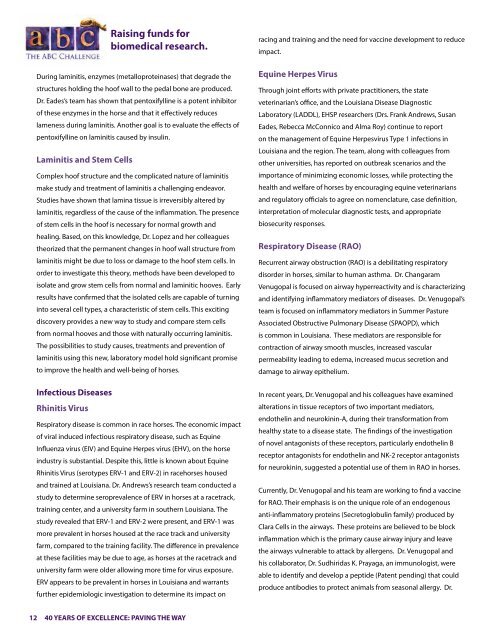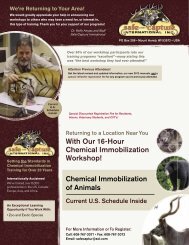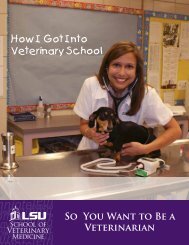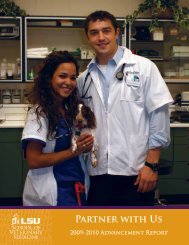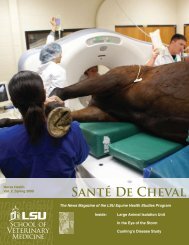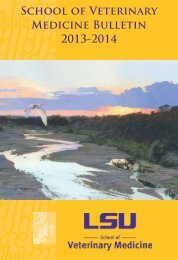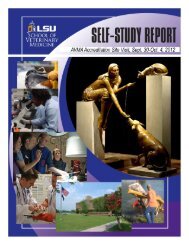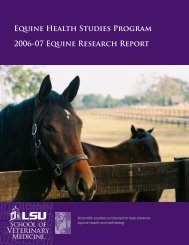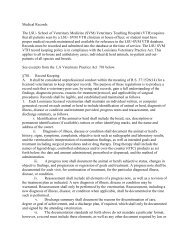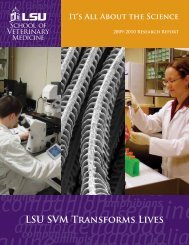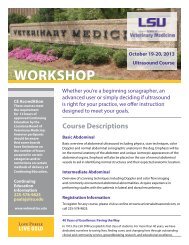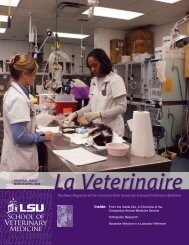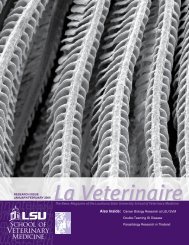Spring 2013 - School of Veterinary Medicine - Louisiana State ...
Spring 2013 - School of Veterinary Medicine - Louisiana State ...
Spring 2013 - School of Veterinary Medicine - Louisiana State ...
You also want an ePaper? Increase the reach of your titles
YUMPU automatically turns print PDFs into web optimized ePapers that Google loves.
During laminitis, enzymes (metalloproteinases) that degrade the<br />
structures holding the ho<strong>of</strong> wall to the pedal bone are produced.<br />
Dr. Eades’s team has shown that pentoxifylline is a potent inhibitor<br />
<strong>of</strong> these enzymes in the horse and that it effectively reduces<br />
lameness during laminitis. Another goal is to evaluate the effects <strong>of</strong><br />
pentoxifylline on laminitis caused by insulin.<br />
Laminitis and Stem Cells<br />
Complex ho<strong>of</strong> structure and the complicated nature <strong>of</strong> laminitis<br />
make study and treatment <strong>of</strong> laminitis a challenging endeavor.<br />
Studies have shown that lamina tissue is irreversibly altered by<br />
laminitis, regardless <strong>of</strong> the cause <strong>of</strong> the inflammation. The presence<br />
<strong>of</strong> stem cells in the ho<strong>of</strong> is necessary for normal growth and<br />
healing. Based, on this knowledge, Dr. Lopez and her colleagues<br />
theorized that the permanent changes in ho<strong>of</strong> wall structure from<br />
laminitis might be due to loss or damage to the ho<strong>of</strong> stem cells. In<br />
order to investigate this theory, methods have been developed to<br />
isolate and grow stem cells from normal and laminitic hooves. Early<br />
results have confirmed that the isolated cells are capable <strong>of</strong> turning<br />
into several cell types, a characteristic <strong>of</strong> stem cells. This exciting<br />
discovery provides a new way to study and compare stem cells<br />
from normal hooves and those with naturally occurring laminitis.<br />
The possibilities to study causes, treatments and prevention <strong>of</strong><br />
laminitis using this new, laboratory model hold significant promise<br />
to improve the health and well-being <strong>of</strong> horses.<br />
Infectious Diseases<br />
Rhinitis Virus<br />
Raising funds for<br />
biomedical research.<br />
Respiratory disease is common in race horses. The economic impact<br />
<strong>of</strong> viral induced infectious respiratory disease, such as Equine<br />
Influenza virus (EIV) and Equine Herpes virus (EHV), on the horse<br />
industry is substantial. Despite this, little is known about Equine<br />
Rhinitis Virus (serotypes ERV-1 and ERV-2) in racehorses housed<br />
and trained at <strong>Louisiana</strong>. Dr. Andrews’s research team conducted a<br />
study to determine seroprevalence <strong>of</strong> ERV in horses at a racetrack,<br />
training center, and a university farm in southern <strong>Louisiana</strong>. The<br />
study revealed that ERV-1 and ERV-2 were present, and ERV-1 was<br />
more prevalent in horses housed at the race track and university<br />
farm, compared to the training facility. The difference in prevalence<br />
at these facilities may be due to age, as horses at the racetrack and<br />
university farm were older allowing more time for virus exposure.<br />
ERV appears to be prevalent in horses in <strong>Louisiana</strong> and warrants<br />
further epidemiologic investigation to determine its impact on<br />
racing and training and the need for vaccine development to reduce<br />
impact.<br />
Equine Herpes Virus<br />
Through joint efforts with private practitioners, the state<br />
veterinarian’s <strong>of</strong>fice, and the <strong>Louisiana</strong> Disease Diagnostic<br />
Laboratory (LADDL), EHSP researchers (Drs. Frank Andrews, Susan<br />
Eades, Rebecca McConnico and Alma Roy) continue to report<br />
on the management <strong>of</strong> Equine Herpesvirus Type 1 infections in<br />
<strong>Louisiana</strong> and the region. The team, along with colleagues from<br />
other universities, has reported on outbreak scenarios and the<br />
importance <strong>of</strong> minimizing economic losses, while protecting the<br />
health and welfare <strong>of</strong> horses by encouraging equine veterinarians<br />
and regulatory <strong>of</strong>ficials to agree on nomenclature, case definition,<br />
interpretation <strong>of</strong> molecular diagnostic tests, and appropriate<br />
biosecurity responses.<br />
Respiratory Disease (RAO)<br />
Recurrent airway obstruction (RAO) is a debilitating respiratory<br />
disorder in horses, similar to human asthma. Dr. Changaram<br />
Venugopal is focused on airway hyperreactivity and is characterizing<br />
and identifying inflammatory mediators <strong>of</strong> diseases. Dr. Venugopal’s<br />
team is focused on inflammatory mediators in Summer Pasture<br />
Associated Obstructive Pulmonary Disease (SPAOPD), which<br />
is common in <strong>Louisiana</strong>. These mediators are responsible for<br />
contraction <strong>of</strong> airway smooth muscles, increased vascular<br />
permeability leading to edema, increased mucus secretion and<br />
damage to airway epithelium.<br />
In recent years, Dr. Venugopal and his colleagues have examined<br />
alterations in tissue receptors <strong>of</strong> two important mediators,<br />
endothelin and neurokinin-A, during their transformation from<br />
healthy state to a disease state. The findings <strong>of</strong> the investigation<br />
<strong>of</strong> novel antagonists <strong>of</strong> these receptors, particularly endothelin B<br />
receptor antagonists for endothelin and NK-2 receptor antagonists<br />
for neurokinin, suggested a potential use <strong>of</strong> them in RAO in horses.<br />
Currently, Dr. Venugopal and his team are working to find a vaccine<br />
for RAO. Their emphasis is on the unique role <strong>of</strong> an endogenous<br />
anti-inflammatory proteins (Secretoglobulin family) produced by<br />
Clara Cells in the airways. These proteins are believed to be block<br />
inflammation which is the primary cause airway injury and leave<br />
the airways vulnerable to attack by allergens. Dr. Venugopal and<br />
his collaborator, Dr. Sudhiridas K. Prayaga, an immunologist, were<br />
able to identify and develop a peptide (Patent pending) that could<br />
produce antibodies to protect animals from seasonal allergy. Dr.<br />
12 40 YEARS OF EXCELLENCE: PAVING THE WAY


